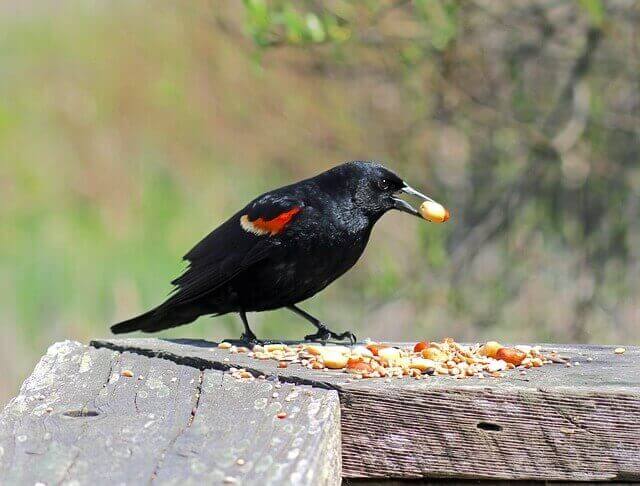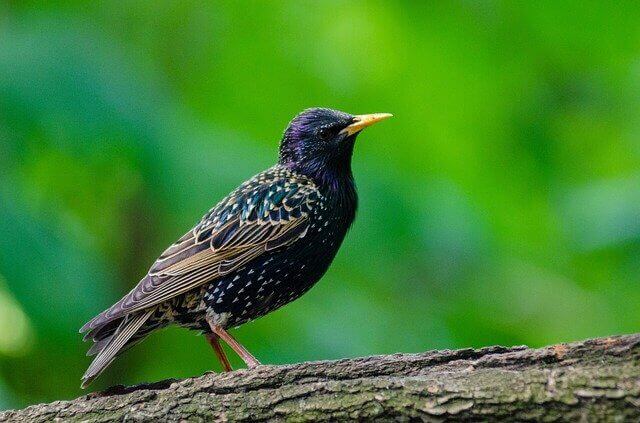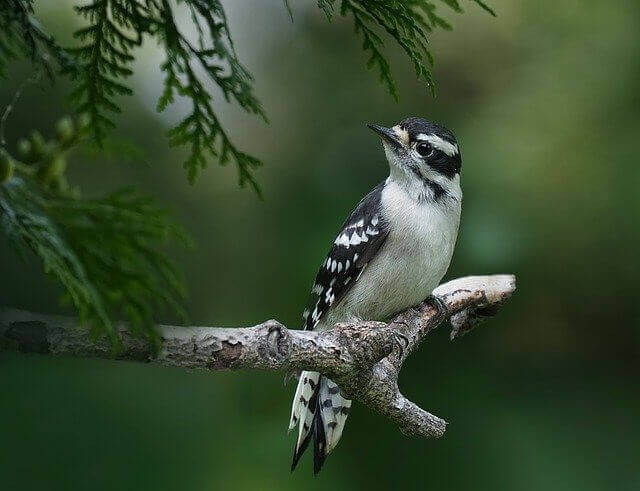Embark on an enthralling journey through Colorado’s diverse birding landscape with our comprehensive guide. This Ultimate Guide showcases the 52 most common birds found throughout the Centennial State, offering insightful details on their habitats, behaviors, and unique attributes.
Whether you’re an avid birdwatcher, a nature enthusiast, or simply curious about Colorado’s rich birdlife, this guide provides a captivating glimpse into the avian diversity that enriches this majestic state. Don’t forget to get your FREE birdwatching checklist for Colorado to enhance your birdwatching experience!
Table of Contents
- 1 Common Backyard Birds In Colorado
- 1.1 American Robin
- 1.2 House Finch
- 1.3 Northern Flicker
- 1.4 Black-billed Magpie
- 1.5 Red-winged Blackbird
- 1.6 Black-capped Chickadee
- 1.7 American Crow
- 1.8 European Starling
- 1.9 Mourning Dove
- 1.10 Eurasian Collared-Dove
- 1.11 Dark-eyed Junco
- 1.12 Blue Jay
- 1.13 Western Meadowlark
- 1.14 Song Sparrow
- 1.15 American Goldfinch
- 1.16 House Sparrow
- 1.17 Common Raven
- 1.18 Downy Woodpecker
- 1.19 Barn Swallow
- 1.20 Common Grackle
- 2 Author
Common Backyard Birds In Colorado
American Robin

Robins are generally found around large trees, or in areas with dense tree cover. They will fly in flocks during mating season and in groups when feeding. Females usually build their nests in large clusters near large branches or trees.
This type of bird can be found in wooded areas, and open fields as well as urban and suburban areas.Their homes are commonly found in hollowed-out logs, old barns, and old cornices. The bird’s diet is varied and it eats mostly seeds, berries, fruits, and insects.
They make a great addition to your backyard bird watching experience. You might even want to set up a bird feeding station near your home so you can view multiple species at one time.
- Frequency: 39.74%
- Color: Mostly brown on the back with an orange-colored breast
- Habitat: Wooded areas, backyards, parks, fields
- Range: USA, Canada, Mexico
- Size: 12 – 16″ inches in length
- Weight: 72 – 95 grams
- Diet: Fruits, berries, and insects (earthworms, beetles, caterpillars)
- Family: Turdidae
- Genus: Turdus
Related Post:
- Interesting American Robin Fun Facts
- Birds that look like Robins but aren’t
- How to attract Robins to your yard?
House Finch
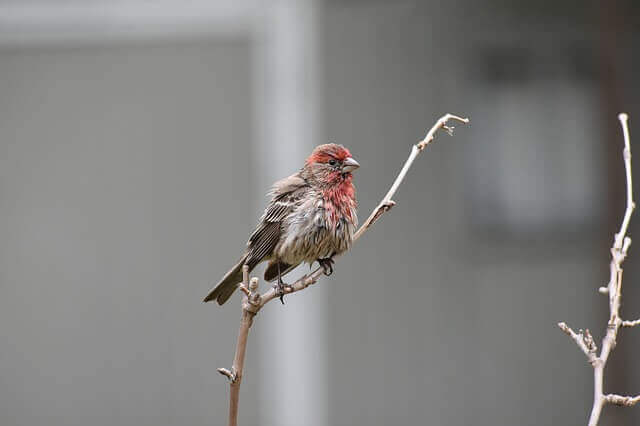
House finches are small, brightly colored birds that can be found in many regions of North America. They live in parks, suburban gardens, and gardens with trees, and near human-built structures such as houses, barns, and outbuildings where they find food.
Their diet consists mainly of seeds from plants such as grasses and weeds, but they also eat insects like flies or beetles when available. They spend their winters in the southernmost parts of Florida to South America, but breed northwards during spring to places like Canada and Alaska.
This is a normal behavior of most finches. Their songs are quite melodic and have a pleasant tone, which is perfect for birdwatching.
- Frequency: 34.30%
- Color: Reddish face and upper breast, brown streaks on back, belly, and tail.
- Habitat: urban and suburban areas, backyards, edges, yards, and parks
- Range: Canada, USA, Mexico
- Size: 5 – 6″ inches
- Weight: 16 – 27 grams
- Diet: Aphids, grains, seeds, berries, nettle, dandelion, sunflower
- Family: Fringillidae
- Genus: Haemorhous
Related Post: How to Attract House Finch to your Yard
Northern Flicker
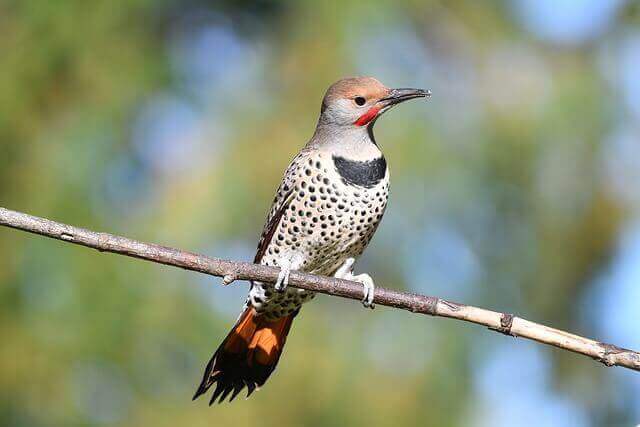
The Northern Flickers are a migratory bird species that inhabit North America. In the winter months they live primarily in deciduous forests and mixed woods habitats where they feed on insects and fruits that can be found year-round in those areas.
But when summer comes, their diet changes to caterpillars, beetles, nuts and berries which are available only at certain times of the year. Migration patterns vary depending on the season, but flickers have been known to migrate up to 1,000 miles north or south of their wintering grounds when food is scarce in their breeding area.
- Frequency: 34.04%
- Color: Light brown with black bars across back, chest, wings, belly
- Habitat: Forests, woodlands, backyards, edges, yards, and parks
- Range: North America, Central America, Cuba, Cayman Islands
- Size: 10 – 14″ inches
- Weight: 85 – 165 grams
- Diet: Insects (ants, beetles, invertebrates), fruits, seeds, berries
- Family: Picadae
- Genus: Colaptes
Related Post: How to Attract Northern Flickers to your Backyard
Black-billed Magpie
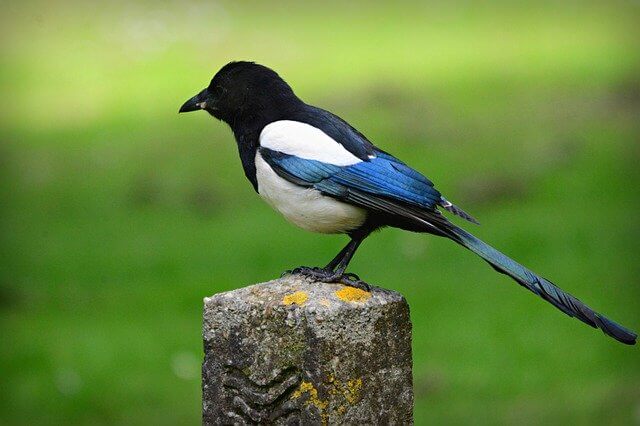
Black-billed Magpies are known to be a common sight in North America. They range from the northern parts of Canada and down through the United States, with populations also found in southern Mexico. Their habitat includes grasslands, marshes, tundra and even mixed forests.
The magpie’s diet consists mainly of insects, worms and other invertebrates, as well as berries and seeds from plants such as wild strawberries or chokeberries. In early spring they migrate northward to breed while returning south in late fall for winter hibernation.
- Frequency: 29.79%
- Color: Mostly black and white plumage, and has blue and green iridescent feathers
- Habitat: Towns, backyards, parks, fields
- Range: USA, Canada
- Size: 18 – 24″ inches long
- Weight: 145 – 215 grams
- Diet: Insects, carrion, seeds, rodents, berries, nuts, eggs
- Family: Corvidae
- Genus: Pica
Red-winged Blackbird
The Red-winged blackbirds are migratory birds that live in the North America. They can be found in the eastern US from Maine to Florida and as far west as Colorado, Utah and Oregon. They spend their winters in Central and South America, while during summer they inhabit mostly open country, fields, marshlands and moist lowland forests.
They are omnivores, which means they eat both plants and animals. In the summer, they feed on insects like grasshoppers and dragonflies while during winter months, their diet consists of berries.
- Frequency: 29.26%
- Color: All black with red patches on shoulder and a yellow wing bar
- Habitat: Deciduous forests, conifers, roadside, rivers, backyards, parks
- Range: North America, Central America
- Size: 6.7 – 7.1″ inches length
- Weight: 41.5 – 65 grams
- Diet: Seeds and insects (butterflies, dragonflies, moths, frogs, worms, spider, snails, carrion, flies.)
- Family: Icteridae
- Genus: Agelaius
Black-capped Chickadee

The Black-capped Chickadee is a small bird that resides in North America as well as some parts of South America. They live mainly in deciduous forests, but they can also be found in coniferous forests with high tree density, forest edges or scrubby understory. Their diet consists of insects such as beetles and spiders; berries such as juniper berries and mountain ash; small seeds like those from red maple trees.
The black capped chickadee is a non-migratory species, but a migration pattern is primarily seen in the Northern Hemisphere where they are an attitudinal migrant during winter months and return to their breeding grounds at higher elevations.
- Frequency: 28.04%
- Color: Black cap, white on face, white/reddish-brown flanks
- Habitat: Deciduous and mixed forests, backyards, parks
- Range: USA and Canada
- Size: 11.5 -16 cm length
- Weight: 8 – 15 grams
- Diet: Insects, seeds, berries
- Family: Paridae
- Genus: Poecile
Related Post: How Do I Attract Chickadees To My Yard?
American Crow
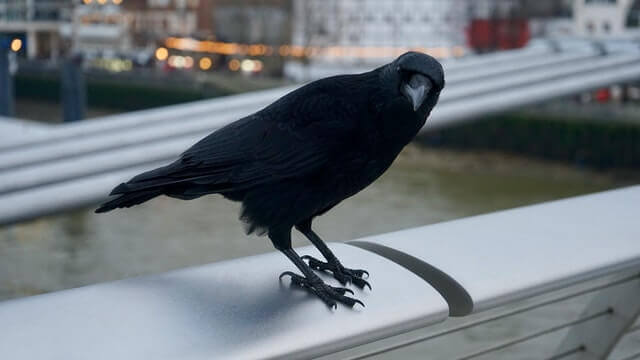
The American Crows are a highly adaptable species. They have the widest range of any North American bird, with about 90% of their population found in Canada and the United States. Their habitat is typically an open wooded area near a water source such as streams or lakes, although they can also be found in urban areas.
They mainly eat invertebrates like insects and earthworms but will also consume small vertebrates like frogs, fish, snakes and birds. In winter, they migrate to warmer regions like Texas or Florida to escape the cold and settle in Arkansas, Tennessee or Kentucky.
- Frequency: 25.93%
- Color: Black
- Habitat: Open country, farms, parks, woodlands, towns, cities
- Range: Canada, USA, Mexico
- Size: 16 – 21″ inches
- Weight: 315 -620 grams
- Diet: invertebrates, carrion, seeds, eggs fish, grains, mice, frogs, and other small animals.
- Family: Corvidae
- Genus: Corvus
Related Post:
European Starling
The European Starlings are one of the most common birds in North America. The bird’s range is widespread, and it can be found throughout much of Canada, all but four states in the US, and down into Mexico. They are a migratory species that spends winter time mostly in central Texas and northern Florida before migrating back north to breed in summer months.
European Starlings have adapted well to living with humans, as they often nest on structures such as power lines or buildings near populated areas. The diet of the European Starling consists mainly of insects, worms and other invertebrates which they find on the ground or in vegetation while foraging
- Frequency: 24.09%
- Color: Black with glossy iridescence plumage
- Habitat: Forests, woodlands, backyards, edges, yards, and parks
- Range: North America, Europe, Africa, India, Middle East, China
- Size: 7 – 9″ inches long
- Weight: 60 – 100 grams
- Diet: Insects (ants, beetles, invertebrates), fruits, seeds, berries
- Family: Picadae
- Genus: Colaptes
Mourning Dove
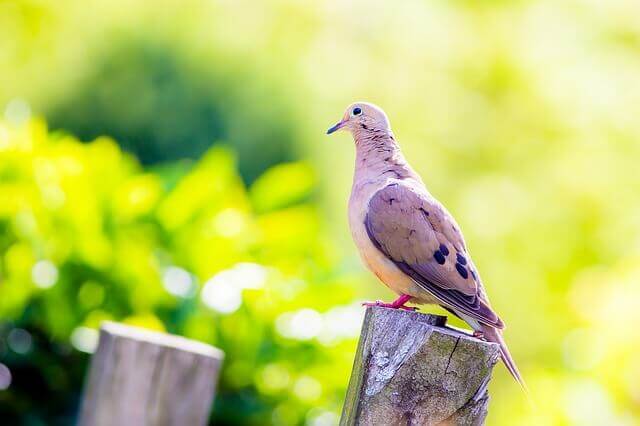
Mourning Doves are a migratory bird that can be found in many areas of the United States. They range from the Gulf Coast, north to southern Canada and south through Mexico and Central America. The Mourning Dove is known for its mourning sound when they call out.
Their diet consists mainly of insects but also feed on seeds, berries, fruit and plants during winter months. Mourning Doves migrate from summer breeding grounds to winter habitats, where they avoid harsh weather conditions by roosting together at night to conserve body heat.
- Frequency: 22.67%
- Color: Light gray-brown and lighter and pinkish below. The wings have black spots.
- Habitat: Open habitats, urban areas, farms, prairie, grassland, wooded area
- Range: USA, Canada, Mexico, Central America, Greater Antilles
- Size: 12″ inches length
- Weight: 112 – 170 grams
- Diet: Rapeseed, corn, millet, safflower, sunflower seeds, pokeberry, sesame, and wheat.
- Family: Columbidae
- Genus: Zenaida
Eurasian Collared-Dove
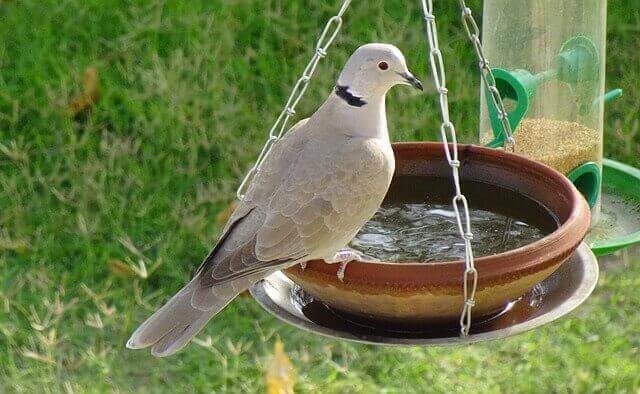
The Eurasian Collared-Dove is a migratory bird that lives in North America, Central America, South America, Europe, and Asia. The ones that reside in North America have a range from the southern tip of Florida, throughout Central America and into South America. Their habitat ranges from open fields to forests, mountains and plains.
The diet for this dove includes seeds, berries, worms and other small animals they can find while hunting for food on the ground or in trees. They migrate south during winter months to escape harsh conditions like snowfall and freezing temperatures.
- Frequency: 22.51%
- Color: Pinkish-gray with ablack half-collar bar with white on its neck
- Habitat: Urban centres, farms, backyards, edges, yards, and parks
- Range: North America, Central America, South America, Europe, Asia
- Size: 13″ inches
- Weight: 150 grams
- Diet: Millet, milo, sunflower, wheat, corn and berries
- Family: Columbidae
- Genus: Streptopelia
Dark-eyed Junco
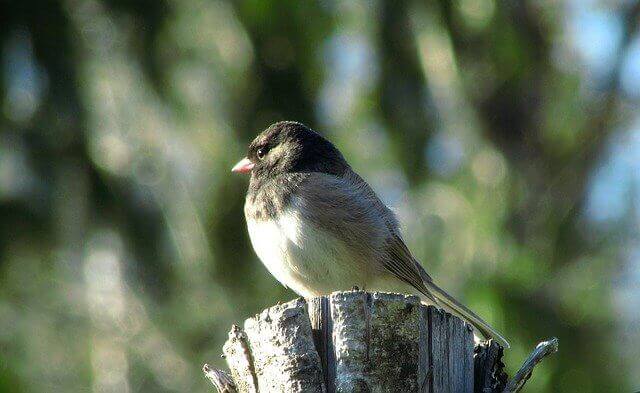
The Dark-eyed Junco is a small, ground dwelling bird. Their range includes most of the eastern United States, southern Canada south to Mexico and Central America. The habitat of this species includes woodland areas, scrubby habitats with scattered trees or forest clearings; agricultural fields, suburban parks, gardens; chaparral or brushy areas; shrubby bogs
The diet of the junco consists mainly of seeds, berries, fruit and insects. There are two major migration patterns for this species: one during fall when they migrate south to avoid harsh winter conditions; and another one during spring when they return north again after breeding season ends.
- Frequency: 20.32%
- Color: Gray head, neck, breast, gray/brown backs and wings, white underside
- Habitat: Wooded areas, forest edges, roadsides, gardens, parks.
- Range: USA and Canada
- Size: 5.1 – 6.9″ inches
- Weight: 18 – 30 grams
- Diet: Seeds, insects, and arthropods
- Family: Passeriformes
- Genus: Junco
Related Post: Interesting Dark-eyed Junco Fun Facts
Blue Jay
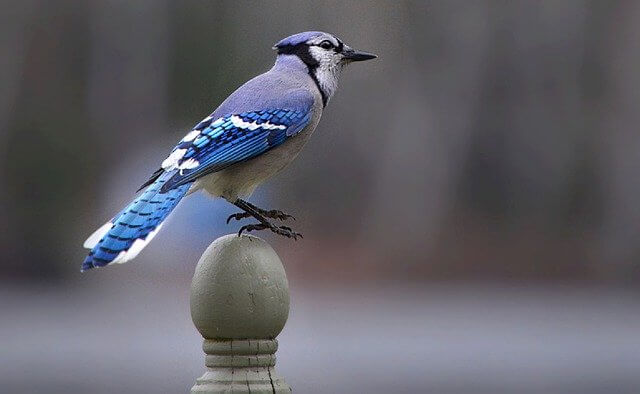
The Blue Jay is a type of jay that lives in North America. They are mainly found in the northern parts of Canada and the United States, and they are also seen around New England during migration periods. They have a variety of habitats from coniferous forests to deciduous forest areas, but they can be spotted on farms as well. The range for this bird spans across eastern Canada and all throughout the United States excluding some southern states like Texas or Florida.
They eat seeds, insects, nuts, berries and acorns which they glean from the ground or break open with their beaks. The northern population can be found as far north as Alaska, but they migrate south to the central United States for wintering grounds from October to March.
- Frequency: 18.05%
- Color: Blue crest on the head, wings, back, and tail, and has a white face and belly
- Habitat: Deciduous and mixed forests, mixed woodlands, backyards, parks
- Range: Southern Canada, Eastern and Central United States, Florida and Texas
- Size: 8 – 12″ inches
- Weight: 70 – 100 grams
- Diet: Nuts, seeds, caterpillars, grasshoppers, and beetles
- Family: Corvidae
- Genus: Cyanocitta
Related Posts:
- How to Attract Blue Jays to your Yard?
- Do Blue Jays Migrate? The Truth
- What do Blue Jay Eat – All The Facts
Western Meadowlark

The Western Meadowlark is a small bird found in North America. It ranges from southern Canada to the central United States and Mexico, and is also found on some Caribbean islands.
The Western Meadowlark prefers open habitats such as grasslands, wetlands, meadows, farmland and even urban areas like parks or golf courses. They eat insects like beetles, crickets, grasshoppers and flies. These birds migrate to avoid cold winters by moving south to warmer climates in Mexico or Central America each year.
- Frequency: 17.40%
- Color: Mostly brown upper with black streaks and yellow underparts
- Habitat: Pastures, prairies, grasslands, and fields,
- Range: Western and central North America
- Size: 8.5″ inches in length
- Weight: 90 – 115 grams
- Diet: Bugs, seeds, berries
- Family: Icteridae
- Genus: Sturnella
Song Sparrow
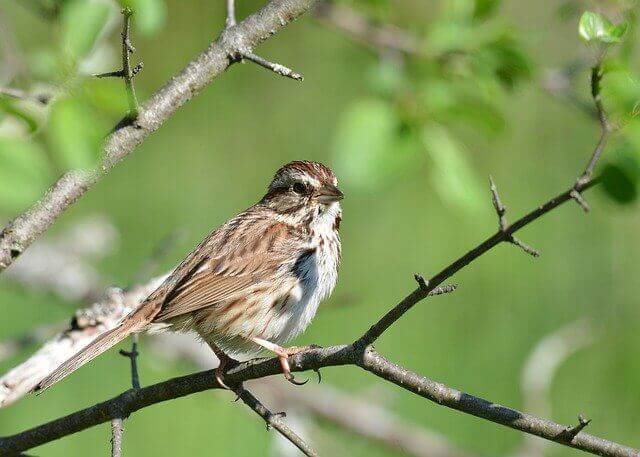
The Song Sparrow is a small songbird native to North America. It has a small range and lives mainly in the eastern half of the United States from coast to coast, as well as much of Canada. The song sparrow prefers open habitats with trees or shrubs for nesting such as prairies, grasslands, meadows and scrubby areas that have scattered bushes.
It prefers dense shrubs and thickets for nesting sites, but also likes open areas with trees nearby. The Song Sparrow’s diet consists of insects such as caterpillars, beetles, ants and grasshoppers along with seeds from weeds and grasses.
- Frequency: 16.51%
- Color: Gray head, white cheek, a black bib, rufous neck
- Habitat: Urban centers, farms, backyards, edges, yards, and parks
- Range: Europe, Mediterranean, Asia, Australasia, Africa, and the Americas
- Size: 5.5 – 7.0″ inches
- Weight: 25 – 40 grams
- Diet: Grains, seeds, and insects
- Family: Passeridea
- Genus: Passer
Related Post: How to Attract Sparrows to your Backyard
American Goldfinch
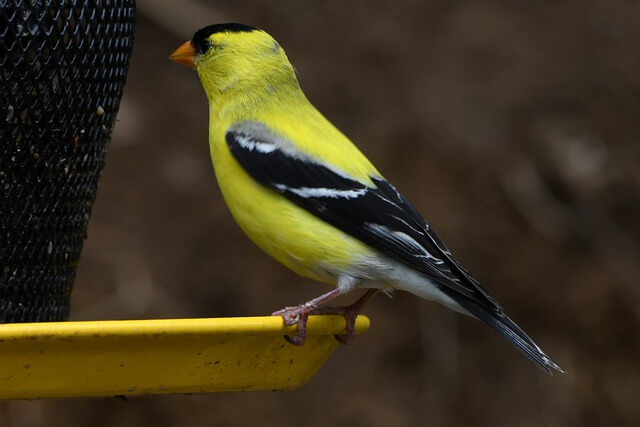
The American Goldfinch is a species of finch that lives in North America. They have been seen from Maine to New Mexico and as far south as Texas. They are mainly found on the ground or in low shrubs or trees where they feed on seeds, fruit and insects. The range includes all types of habitat with different climates, but prefers places near water sources such as rivers or lakes.
In order to maintain a healthy population in these habitats, they must migrate south during the winter months because the habitat will be too cold for them to survive there year-round. They typically return from November through March or April.
- Frequency: 16.41%
- Color: Face, neck, and underside are yellow, black wings with white bars
- Habitat: Deciduous forests and thickets, roadside, grasslands, backyards, meadows
- Range: Canada, USA and Mexico
- Size: 4.3 – 5.5″ inches length
- Weight: 12 -18 grams
- Diet: Grass, dandelions, chickweed, sunflowers and ragweed, thistle, red alder, birch, spruce seeds
- Family: Carduelinae
- Genus: Spinus
Related Post: American Goldfinch Interesting Facts
House Sparrow

House sparrows are a common species of bird found in the United States, with range extending to northern South America. They live primarily in cities or agricultural areas where there is easy access to food sources such as small seeds, nectar, worms, insects, human waste, grain crops and garbage dumps.
House sparrows are known for their migratory pattern which occurs from September through March where they will travel up to 500 miles south during winter months. They live in large numbers because they nest near each other which helps them find food more easily.
- Frequency: 16.00%
- Color: Gray head marking, a reddish-brown back, and gray underparts
- Habitat: Urban centers, suburban areas, backyards, edges, yards, and parks
- Range: North America, Central America, South America, Africa, Australia, New Zealand
- Size: 5.5 – 7.1″ inches in length
- Weight: 25 – 39 grams
- Diet: Insects, beetles, caterpillars, aphids,, grasshoppers, crustaceans, earthworms, vertebrates
- Family: Passeridea
- Genus: Passer
Related Post: How to Attract Sparrows to your Backyard
Common Raven
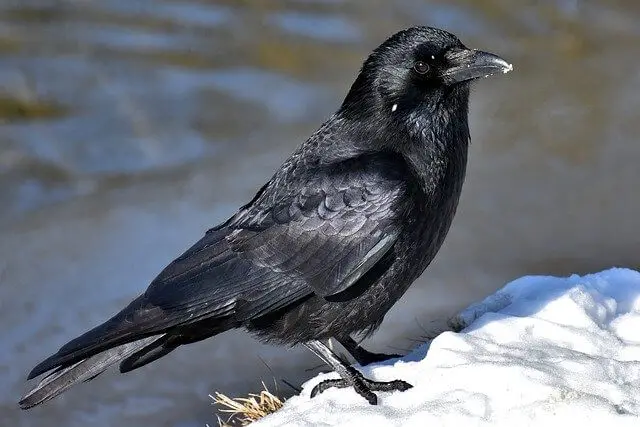
The Common Raven is a large black bird that lives in Northern Europe, Asia and North America. They have been seen all over the world including India, Japan, South Africa and New Zealand. They live in many habitats such as coniferous forests, mixed woodlands, deserts and open countrysides. The raven’s diet consists of carrion, eggs, fish, frogs and other small animals.
Ravens migrate from one place to another during winter because of food shortages, and because they need warmer climates due to their metabolism which can’t handle cold temperatures very well.
- Frequency: 15.36%
- Color: All black iridescent plumage
- Habitat: Wooded areas, evergreen forests, tundra, roadside, grasslands, backyards, parks
- Range: Found throughout the Northern Hemisphere
- Size: 21 – 26 inches long
- Weight: 1.5 – 4.5 lbs.
- Diet: Mainly scavengers, feeding on carrion, beetles and maggots.
- Family: Corvidae
- Genus: Corvus
Downy Woodpecker
The Downy Woodpecker is a type of woodpecker. They range from Eastern Canada to Northern Mexico and are found in the US, southern Canada, and parts of South America. The Downy Woodpecker’s habitat ranges across deciduous forests that have trees with bark, as well as coniferous forests with trees such as pine, spruce or fir.
The diet of the Downy Woodpecker consists mainly of insects such as ants, beetles, caterpillars, crickets, moths, spiders which they find by pecking at the bark on a tree, as well as tree sap. Downy Woodpeckers migrate to warmer climates during winter time and will return when it starts getting warmer again.
- Frequency: 14.54%
- Color: Black with a white throat, belly, and back. White spots on wings
- Habitat: Deciduous forests and thickets, roadside, grasslands, backyards, parks
- Range: Canada, USA, and Mexico
- Size: 5.5 – 7.1″ inches in length
- Weight: 20 – 33 grams
- Diet: Mostly insects and beetles and ants, also gall wasps, caterpillars
- Family: Picadae
- Genus: Dryobates
Related Post:
Barn Swallow
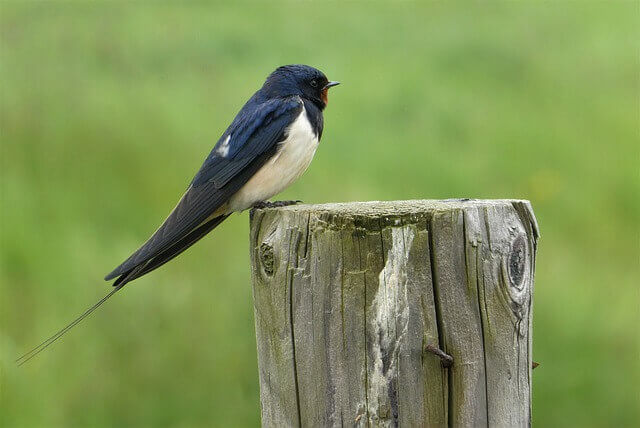
Barn Swallows can be found throughout the USA and Canada. They are often seen near tree stumps, large branches, twigs, and eating insects.
Barn Swallows feed in groups. Usually around twenty or thirty birds will congregate in a single area foraging. They can roost such as hollowed out logs, trees, arbors, or hollowed out crevices in the ground.
Barn Swallows are often found nesting in large numbers in barns. They sometimes build their own nest, but some barns house hundreds of them. The nest is made out of mud and feathers.
- Frequency: 14.45%
- Color: Blue upperparts and a reddish-brown forehead, throat and chin, whitish-gray underparts and a blue band on breast.
- Habitat: Open country, pastures, meadows, parks, backyards and fields
- Range: Canada, United States, Central and South America
- Size: 6.5″ – 7.5″ inches long
- Weight: 16 – 22 grams
- Diet: Berries, seeds, insects
- Family: Hirundinidae
- Genus: Hirundo
Common Grackle
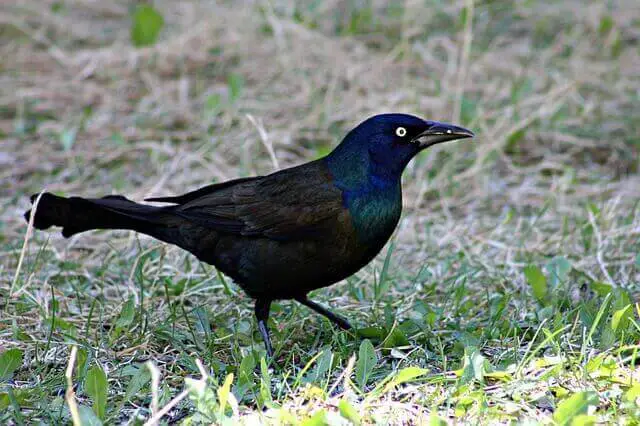
The common grackle (Turdus migrans) is a medium sized icterid found widely throughout North America. Grackles feed on a variety of small insects, including mosquitoes, dragonflies, flies, and bugs. They are omnivorous, eating both meat and vegetation, although they sometimes snack on plant matter, too.
Common grackles do not migrate; however, they occasionally build nests on the ground or in caves. Males and females can be seen at the same time of year, although they are more commonly seen in summer.
A breeding population usually occurs in June, and the eggs hatch in early August. Common grackles can be found from Maine west to Minnesota. In Colorado and North Carolina, they occur in both urban and rural areas.
- Frequency: 14.19%
- Color: Black overall with a blue, and purple iridescence. Its body plumage is a shimmering copper color.
- Habitat: Woodlands, marshes, meadows, parks, backyards and fields
- Range: East of the Canadian Rockies,Canada and the United States
- Size: 11 – 13″ inches length
- Weight: 75 – 143 grams
- Diet: minnows, eggs, berries, seeds, grain, insects, frogs, mice
- Family: Icteridae
- Genus: Quiscalus
These backyard birds all have a frequency of less than 14% all year-round
- Killdeer 13.89% Frequency
- House Wren 13.34%
- Mountain Chickadee 13.24%
- Rock Pigeon 13.23%
- Broad-tailed Hummingbird 13.05%
- American Kestrel 12.99%
- Spotted Towhee 12.63%
- White-breasted Nuthatch 12.47%
- Yellow-rumped Warbler 11.16%
- White-crowned Sparrow 10.88%
- Yellow Warbler 9.61%
- Steller’s Jay 9.30%
- Pine Siskin 8.99%
- Belted Kingfisher 8.91%
- Chipping Sparrow 8.89%
- Western Kingbird 8.35%
- Say’s Phoebe 8.30%
- Red-breasted Nuthatch 8.09%
- Violet-green Swallow 7.89%
- Woodhouse’s Scrub-Jay 7.76%
- Lesser Goldfinch 7.58%
- Western Wood-Pewee 7.38%
- Common Goldeneye 7.23%
- Brown-headed Cowbird 7.12%
- Tree Swallow 7.01%
- Cliff Swallow 6.44%
- Mountain Bluebird 6.33%
- Bullock’s Oriole 6.21%
- Hairy Woodpecker 5.62%
- Townsend’s Solitaire 5.55%
- Pygmy Nuthatch 5.51%
- Lesser Scaup 5.08%
Related Posts:
- 13 Woodpeckers in Colorado for 2023 (Complete ID Guide!)
- 14 Types of Owls in Colorado for 2023 (Full ID Guide!)
Source: *Frequency of occurrence percentage provided by: eBird


